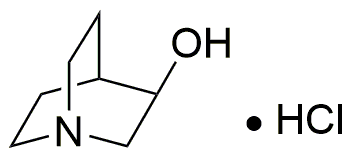(R)-(-)-3-Quinuclidinol hydrochloride is widely utilized in research focused on
- Pharmaceutical Development: This compound serves as a key intermediate in the synthesis of various pharmaceuticals, particularly in the development of analgesics and anti-inflammatory drugs, enhancing their efficacy.
- Neuroscience Research: It is used in studies related to neurotransmitter systems, helping researchers understand the mechanisms of action for certain central nervous system drugs.
- Chiral Catalysis: The compound plays a role in asymmetric synthesis, acting as a chiral catalyst that improves the selectivity and yield of chemical reactions, which is crucial in producing enantiomerically pure compounds.
- Analytical Chemistry: It is employed as a reference standard in analytical methods such as HPLC and GC, ensuring accurate quantification and identification of related compounds in complex mixtures.
- Material Science: The compound is explored for its potential applications in developing new materials, particularly in creating polymers with specific properties, benefiting industries like coatings and adhesives.
Informations générales
Propriétés
Sécurité et réglementation
Applications
(R)-(-)-3-Quinuclidinol hydrochloride is widely utilized in research focused on
- Pharmaceutical Development: This compound serves as a key intermediate in the synthesis of various pharmaceuticals, particularly in the development of analgesics and anti-inflammatory drugs, enhancing their efficacy.
- Neuroscience Research: It is used in studies related to neurotransmitter systems, helping researchers understand the mechanisms of action for certain central nervous system drugs.
- Chiral Catalysis: The compound plays a role in asymmetric synthesis, acting as a chiral catalyst that improves the selectivity and yield of chemical reactions, which is crucial in producing enantiomerically pure compounds.
- Analytical Chemistry: It is employed as a reference standard in analytical methods such as HPLC and GC, ensuring accurate quantification and identification of related compounds in complex mixtures.
- Material Science: The compound is explored for its potential applications in developing new materials, particularly in creating polymers with specific properties, benefiting industries like coatings and adhesives.
Documents
Fiches de données de sécurité (FDS)
La FDS fournit des informations de sécurité complètes sur la manipulation, le stockage et l’élimination du produit.
Spécifications du produit (PS)
Le PS fournit une description complète des propriétés du produit, notamment sa composition chimique, son état physique, sa pureté et les exigences de stockage. Il détaille également les plages de qualité acceptables et les applications prévues du produit.
Certificats d'analyse (COA)
Recherchez des certificats d'analyse (COA) en saisissant le numéro de lot du produit. Les numéros de lot et de lot se trouvent sur l'étiquette d'un produit, après les mots « Lot » ou « Lot de fabrication ».
Numéro de catalogue
Numéro de lot/série
Certificats d'origine (COO)
Ce certificat d'exploitation confirme le pays dans lequel le produit a été fabriqué, et détaille également les matériaux et composants utilisés et s'il est issu de sources naturelles, synthétiques ou autres sources spécifiques. Ce certificat peut être requis pour les douanes, le commerce et la conformité réglementaire.
Numéro de catalogue
Numéro de lot/série
Fiches de données de sécurité (FDS)
La FDS fournit des informations de sécurité complètes sur la manipulation, le stockage et l’élimination du produit.
DownloadSpécifications du produit (PS)
Le PS fournit une description complète des propriétés du produit, notamment sa composition chimique, son état physique, sa pureté et les exigences de stockage. Il détaille également les plages de qualité acceptables et les applications prévues du produit.
DownloadCertificats d'analyse (COA)
Recherchez des certificats d'analyse (COA) en saisissant le numéro de lot du produit. Les numéros de lot et de lot se trouvent sur l'étiquette d'un produit, après les mots « Lot » ou « Lot de fabrication ».
Numéro de catalogue
Numéro de lot/série
Certificats d'origine (COO)
Ce certificat d'exploitation confirme le pays dans lequel le produit a été fabriqué, et détaille également les matériaux et composants utilisés et s'il est issu de sources naturelles, synthétiques ou autres sources spécifiques. Ce certificat peut être requis pour les douanes, le commerce et la conformité réglementaire.


